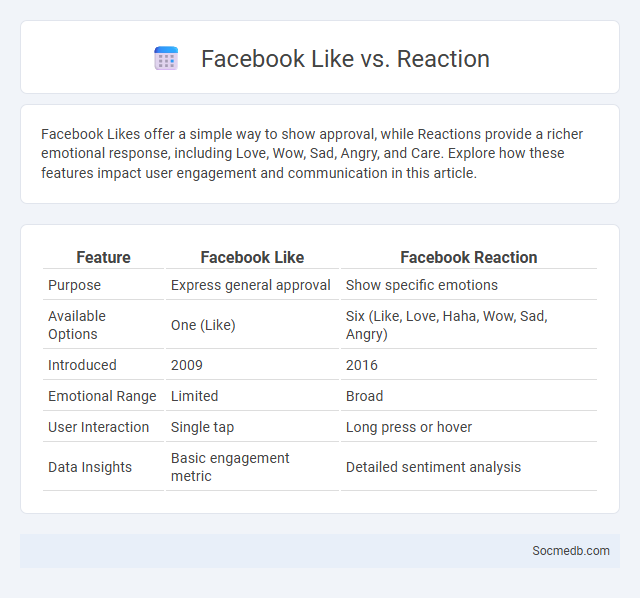
Photo illustration: Facebook Like vs Reaction
Facebook Likes offer a simple way to show approval, while Reactions provide a richer emotional response, including Love, Wow, Sad, Angry, and Care. Explore how these features impact user engagement and communication in this article.
Table of Comparison
| Feature | Facebook Like | Facebook Reaction |
|---|---|---|
| Purpose | Express general approval | Show specific emotions |
| Available Options | One (Like) | Six (Like, Love, Haha, Wow, Sad, Angry) |
| Introduced | 2009 | 2016 |
| Emotional Range | Limited | Broad |
| User Interaction | Single tap | Long press or hover |
| Data Insights | Basic engagement metric | Detailed sentiment analysis |
Understanding Facebook Likes and Reactions
Facebook likes and reactions provide key insights into user engagement by measuring emotional responses to posts, including options like Love, Haha, Wow, Sad, and Angry. These interactions influence content visibility through Facebook's algorithm, which prioritizes posts with higher engagement to enhance user experience. Analyzing the distribution and type of reactions helps businesses and content creators tailor their strategies to resonate more effectively with their audience.
The Evolution of Facebook Engagement Tools
Facebook engagement tools have evolved significantly, introducing features like React buttons to provide nuanced user interactions beyond simple likes. The platform incorporated live video streaming, enabling real-time audience engagement and boosting content visibility. Advanced algorithms now personalize news feeds, optimizing user interaction by prioritizing relevant posts, comments, and community-driven content.
Differences Between a Like and a Reaction
A like on social media is a simple acknowledgment indicating approval or enjoyment, represented by a thumbs-up icon or heart. Reactions expand this interaction by allowing users to express a range of emotions such as love, laughter, anger, or sadness through multiple emoji options. These diverse reaction options provide richer feedback and more nuanced user engagement metrics compared to the single-response nature of likes.
The Psychology Behind Likes vs. Reactions
The psychology behind likes versus reactions on social media reveals subtle differences in how users express emotions and validate content. Likes often serve as a quick, positive affirmation, signaling approval or basic acknowledgment, while reactions provide a broader emotional spectrum, enabling users to convey empathy, humor, or surprise. Understanding the impact of both can help you tailor your content to foster deeper engagement and emotional connection with your audience.
How Likes and Reactions Affect Your Facebook Reach
Likes and reactions on your Facebook posts play a crucial role in determining your content's reach by signaling engagement to the algorithm. Higher engagement rates increase the likelihood that Facebook will prioritize your posts in newsfeeds, expanding your audience and boosting visibility. Understanding how these interactions impact reach can help you craft strategies that enhance your social media presence effectively.
User Preferences: Like or React?
User preferences on social media significantly impact engagement metrics, with reactions offering a broader emotional spectrum beyond the traditional "like." Platforms like Facebook have diversified interactions through options such as "love," "haha," and "angry," enabling nuanced user feedback and more precise content analysis. Understanding these varied user responses allows marketers to tailor strategies that increase relevance and foster deeper connections with target audiences.
Impact on Facebook Algorithm: Likes vs. Reactions
Facebook's algorithm prioritizes content based on user interactions, with reactions such as Love, Wow, and Angry carrying more weight than simple Likes, signaling stronger emotional engagement. Posts receiving diverse reactions are more likely to be promoted in users' news feeds due to higher perceived relevance and engagement quality. The algorithm's sensitivity to reaction types influences content visibility, encouraging creators to generate emotionally resonant posts for enhanced reach.
Business Insights: Measuring Engagement with Likes and Reactions
Analyzing business insights through social media engagement metrics such as likes and reactions provides valuable data on audience preferences and content effectiveness. These interactions serve as quantitative indicators of user sentiment, helping businesses tailor marketing strategies to increase brand loyalty and customer retention. Tracking trends in engagement patterns enables companies to optimize content delivery timing and enhance overall digital marketing performance.
When to Use a Like Versus a Reaction
Using a Like on social media is ideal for simple acknowledgment or approval of a post, signaling basic engagement without conveying specific emotions. Reactions should be employed when expressing nuanced feelings such as love, laughter, surprise, sadness, or anger, enhancing communication through emotional context. Selecting the appropriate response based on content intent helps improve interaction quality and fosters meaningful online connections.
Future Trends in Facebook Engagement
Future trends in Facebook engagement emphasize immersive content formats such as augmented reality (AR) and live video, which boost user interaction and retention. AI-driven personalization enhances content relevance, increasing your audience's engagement by delivering tailored experiences. Investing in community-building features like Facebook Groups will foster deeper connections and sustained user participation.
 socmedb.com
socmedb.com